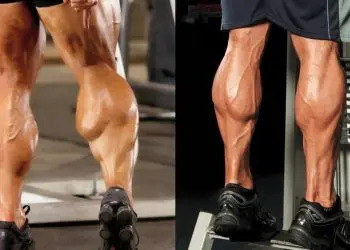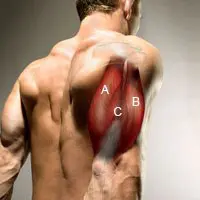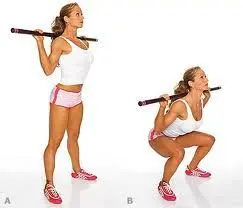
If you recall it was the large muscles of the back that was the focus of the muscles names and functions post, that is always the subject matter of part 1 of Muscle Talk. As everyone knows when it comes to back training, it’s our lats and traps that we are targeting for the most part. Of course all sorts of other muscles become involved in the process, but generally those two massive muscles are going to do the brunt of the work. As it is largely the lats and traps that are doing the most work, as well as show the most superficial development, it is only natural that those are the main muscles that are trained with the most intensity. As always is the case here at this corner of the internet, there is more to the story, so let’s get into that now.
Before we get into the specifics of some of the exercises that each qualify as an absolute must do, I want to revisit something I spoke of before, which deals with training splits. I’m a big believer in pairing back day with hamstrings. The most effective way to train either your hamstrings, or your back involves a fairly large helping from the both muscle groups. As such it just makes sense to maximize the training stimulus, and hit both areas hard at the same time. As I alluded to above, it is largely the same movements that will be the most effective for both sets of muscle groups. As this article is focused on back specific training, I’ll do my best to stay on that subject…right after I say this next part.
My reasoning for pairing these two muscle groups hinges around this thought regarding back exercises – if for no other reason than to put a good number of heavy sets featuring the traditional deadlift as the first back/glute/hamstring exercise. As far as developing your posterior chain, there is no exercise that does this better. It’s one of those jack of all trades kind of lifts. It doesn’t target anything specifically – but all the muscles on the back side of your body anywhere between your ankles and your skull are getting worked very efficiently, and with a lot of intensity. Whether the muscles are directly involved in pulling, or indirectly through the stability required by the spine, knees, hips and, shoulders, this movement is a must for any serious training program.
Moving on to my second favorite exercise when it comes to back training – is the bent over barbell row. This exercise targets the latissimus dorsi, the teres major, the middle trapezius, the rhomboids, and the posterior deltoids. There is also going to be a lot of lower body strength invloved in stabilizing the foundation (our legs), as well as a lot of core stability. This is a great movement that is also a versatile one. You can transfer the stress to different areas of the back by changing the grip from a pronated grip to a supinated one, as well as from narrow to wide. I encourage you to experiment with various grips and widths, and to focus on how each feels different when the back muscles are both in the stretched, as well as the contracted positions.
Another alternative to barbell rows is the dumbbell row. There are numerous advantages to this exercise as a compliment or an alternative to barbell rows. You are able to stabilize your torso using your free arm, so the amount of weight that is rowed can be maximal. Barbell rows are slightly more limiting in this respect as there is the safety of the low back to consider. With one arm dumbbell rows, you can use as heavy a weight as is possible with little danger. There is also a slight increase in the range of motion, as you are rowing up past your torso to your hip. I also like to stretch and extend my arm forward in the bottom position to give my lats a really good stretch. Even though the torso is stabilized by the free arm, there is still a lot of core activation in this exercise, especially if done as heavy as is possible. It isn’t an easier version of the barbell row if done correctly.
Level Up Your Fitness: Join our 💪 strong community in Fitness Volt Newsletter. Get daily inspiration, expert-backed workouts, nutrition tips, the latest in strength sports, and the support you need to reach your goals. Subscribe for free!
Level Up Your Fitness: Join our 💪 strong community in Fitness Volt Newsletter. Get daily inspiration, expert-backed workouts, nutrition tips, the latest in strength sports, and the support you need to reach your goals. Subscribe for free!
Another in the list of must do exercises for the muscles of the latissimus dorsi, teres major, middle trapezius and posterior deltoid is the wide grip pull-up. Wide grip pull-ups have the advantage over chin ups as a pure back mass builder as a result of the biceps not being in a position of strength due to the overhand grip. Chin-ups can be very reliant on biceps strength, more so if the hands are relatively close together. Something else the wide grip pull-up offers is the pronounced V taper that is highly sought by all weight training enthusiasts. This is as a result of the lats having to work so hard because of the wide and overhand grip. This forces the lats to flare outward as they contract, growing in width with every rep.
The pull-up is also a tremendous core workout if you maintain a rigid torso during the movement. Our body wants to swing to generate momentum, and it will be the responsibility of our core to prevent that from happening. Try holding your torso completely rigid, straight up and down, and take notice of your abs the next morning. You may have to remember what it was that you did to cause them to feel so sore. In time of course your body will adapt, and this soreness will not be an issue. You may also notice that your rep totals will drop at first due to the lack of momentum generated from swinging. Don’t worry, as your lats and core grow stronger, momentum will be a distant memory as true strength takes its place.
The last exercise that I am including as a must do is the inverted row. I remember staying away from this exercise for years because it looked like a lazy persons version of a barbell row – this is simply not the case. The way that I like to perform it is on a smith machine with an exercise ball. I set the bar to the same height as the ball, so that when I’m in the top position with my core held very tight, I’m parallel to the floor. Taking this one step further, I do 20 reps – 10 each with one leg raised off of the ball. This forces my core to work very hard to stabilize my torso to prevent my foot from rolling off the ball, as well as maintaining a rigid torso – not to mention the high rep nature of this exercise makes a great finisher for a awesome pump. This is an incredible back exercise for cuts, as well as overall body conditioning. This will test your body’s ability to work together as one, as well as test the endurance of your lats, traps, rhomboids, teres major, and posterior deltoids.
These exercises make for a great foundation to any mass building or functional training program where the back is the desired target. Both rowing and pull-ups are extremely natural movements, and that makes them highly suited for our purposes as a training stimulus. I didn’t discuss reps, but in general the 6 – 12 range is where I like to work. The back muscles are built for power, so lower reps can be very advantageous. In the case of deadlifts, I feel that heavy sets for low reps in the 3 – 5 range to be ideal. It is just logic in the sense that in our life we would really only use such a movement for lifting something very heavy up off of the ground.
The increased focus on muscle is very gratifying to me personally. It’s a pleasure to talk about and share the information that we have put together here at Team FitnessVolt.com. Next week on Muscle Talk our journey to the various muscle groups will be leaving the posterior chain for a little while. Of course there is always more information to learn and to share, and we are by no means finished with it. For now though, it is time to venture to new lands and see what there is to be learned that can be of benefit to our training knowledge and subsequent goals. Up first is the very popular Fat Loss Facts series, which will be taking the next step in passing along the skills and information necessary to develop the ideal fat loss diet that is suited specifically to your goals. Until tomorrow my friends,
Happy Lifting!








